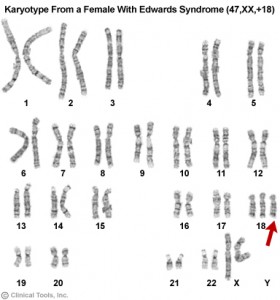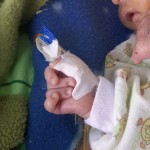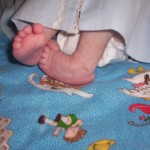
Republican Presidential candidate Rick Santorum had to leave the campaign trail last weekend when his 3-year-old daughter Isabella (Bella) had to be hospitalized. Bella has a serious genetic disorder called Trisomy 18, and was admitted to a Virginia Children’s Hospital with pneumonia in both lungs.
Bella is the youngest of the seven Santorum children. It was noticed at birth that she was “different” and at five days of age, Santorum and his wife Karen were given the diagnosis of Trisomy 18. They were also told that the life expectancy of children with Trisomy 18 was usually very short and that she would probably not live more than a year. Despite these predictions, the Santorums told doctors that “we were not going to concentrate on her dying, we're going to concentrate on her living, and do everything we can to help her.” Despite frequently hospitalizations, especially during her first year of life, Santorum remains upbeat:
Some people describe people like Bella as disabled children … I look at the joy, the simplicity and the love that she emits and its clear to me that we're the disabled ones. Not her … she’s got it right.
Reports from later today indicate that Bella is “turned the corner" and it is hoped that she will be discharged home soon.
We wish her a speedy recovery.
What is a Trisomy?
Let's take a short walk down memory lane and review a little basic genetics:
Meiosis is a special type of cell division necessary for sexual reproduction. The cells produced by meiosis are called gametes which in humans refer to sperm and egg cells.
Meiosis differs from the "life-cycle" cell division of mitosis in two important respects:
- The chromosomes in meiosis undergo a recombination which shuffles the genes, producing a different genetic combination in each gamete, compared with the co-existence of each of the two separate pairs of each chromosome (one received from each parent) in each cell, which results from mitosis.
- The outcome of meiosis is four (genetically unique) haploid cells, compared with the two (genetically identical) diploid cells produced from mitosis.

Meiosis begins with one diploid cell containing two copies of each chromosome (46 total) — one maternal and one paternal — and produces four haploid cells containing one copy of each chromosome (23 chromosomes). Each of the resulting chromosomes in the gamete cells is a unique mixture of maternal and paternal DNA, ensuring that offspring are genetically distinct from either parent.
Nondisjunction is the failure of chromosome pairs to separate properly during meiosis stage 1 or stage 2. It results in a cell with an imbalance of chromosomes, and the cell is said to be aneuploid.
If the chromosome pairs fail to separate properly during cell division, the egg or sperm may have a second copy of one of the chromosomes. If such a gamete results in fertilization and an embryo, the resulting embryo may also have an entire copy of the extra chromosome.
"Full trisomy" means that an entire extra chromosome has been copied. "Partial trisomy" means that there is an extra copy of part of a chromosome.
Trisomies can occur with any chromosome, but often result in miscarriage. For example, Trisomy 16 is the most common trisomy in humans, occurring in more than 1% of pregnancies. This condition, however, usually results in spontaneous miscarriage in the first trimester.
Of those trisomies that survive until birth, the most common is Trisomy 21 or Downs Syndrome. Trisomy 18, also known as Edwards Syndrome, is the next most frequent, followed by Trisomy 13 or Patau Syndrome.
What is Trisomy 18?
 Trisomy 18 is a relatively common genetic disease, occurring in 1 out of every 5000 live births. It is three times more common in girls than boys.
Trisomy 18 is a relatively common genetic disease, occurring in 1 out of every 5000 live births. It is three times more common in girls than boys.
Most cases of trisomy 18 are not inherited, but occur as random events during meiosis. This means that parents have done nothing before or during pregnancy to cause this disorder in their child.
Approximately 5% of people with trisomy 18 have an extra copy of chromosome 18 in only some of the body's cells. In these people, the condition is called mosaic trisomy 18. The severity of mosaic trisomy 18 depends on the type and number of cells that have the extra chromosome. The development of individuals with this form of trisomy 18 may range from normal to severely affected.
Very rarely, the long (q) arm of chromosome 18 becomes attached (translocated) to another chromosome during the formation of gametes or very early in embryonic development. Affected people have two copies of chromosome 18, plus extra material from chromosome 18 attached to another chromosome. If only part of the q arm is present in three copies, the physical signs of translocation trisomy 18 may be different from those typically seen in trisomy 18. If the entire q arm is present in three copies, individuals may be as severely affected as if they had three full copies of chromosome 18.
What are the features of Trisomy 18?
The material in the extra chromosome interferes with normal development. These developmental issues are also associated with medical complications that are potentially life-threatening in the early months and years of life. Fifty percent of babies who are carried to term will be stillborn. Only 10% of children with Trisomy 18 survive to their first birthday.The features of Trisomy 18 include:
- Clenched hands
- Crossed legs (preferred position)
- Feet with a rounded bottom (rocker-bottom feet)
- Low birth weight
- Low-set ears
- Mental deficiency
- Small head (microcephaly)
- Small jaw (micrognathia)
- Underdeveloped fingernails
- Undescended testicle
- Unusual shaped chest (pectus carinatum)
Other signs include eye abnormalities including coloboma of the iris, umbilical or inguinal hernia, and diastasis recti.
There are often signs of congenital heart disease, the most common being atrial septal defect(ASD), ventricular septal defect (VSD), or patent ductus arteriosus (PDA).
 Tests may also show kidney problems, including:
Tests may also show kidney problems, including:
- Horseshoe kidney
- Hydronephrosis
- Polycystic kidney
According to the Trisomy 18 Foundation, “although less than 10 percent survive to their first birthdays, some children with Trisomy 18 can enjoy many years of life with their families, reaching milestones and being involved with their community. A small number of adults (usually girls) with Trisomy 18 have and are living into their twenties and thirties, although with significant developmental delays that do not allow them to live independently without assisted caregiving.”


